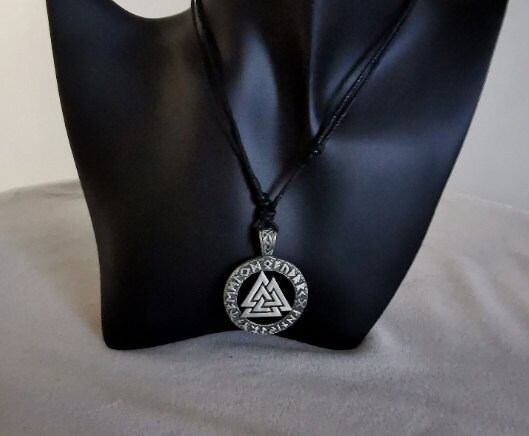The word "Valknut" is a modern term derived from the Old Norse words valr (meaning "slain warriors") and knut (meaning "knot"). While the term itself is not found in historical texts, the symbol appears in various archaeological discoveries, particularly in connection with death and the afterlife.
One of the most notable places where the Valknut is found is the Stora Hammars stones in Sweden. These ancient runestones, dated to the Viking Age, depict battle scenes, Odin, and sacrificial rituals, with the Valknut prominently displayed. Additionally, the symbol appears on other funerary stones and artifacts, often accompanied by depictions of Odin, the Allfather of Norse mythology. This connection has led many scholars to believe that the Valknut is associated with the warrior's journey to the afterlife, specifically Valhalla, Odin’s great hall where fallen warriors are believed to reside.
Many interpretations link the Valknut to Odin, the Norse god of war, wisdom, and death. Odin is known for guiding fallen warriors to Valhalla, and the symbol’s frequent appearance in burial contexts suggests a connection to this role. Some theories suggest that the Valknut represents Odin’s power to bind and unbind the fates of warriors, reinforcing the idea that those marked by it were destined for a glorious afterlife.
In Norse mythology, Odin is also associated with magic, particularly the esoteric practice of seidr, a form of sorcery that allowed him to alter fate and control the minds of others. Some scholars propose that the Valknut may have been a magical sigil, granting protection, courage, or even the ability to control one's destiny in battle. This could explain why the symbol is so often found in places related to death and warfare.
Since the meaning of the Valknut is not explicitly documented in Norse texts, its significance is open to interpretation. Some of the most popular theories include:
The Knot of the Slain – As its name suggests, the Valknut may represent the binding of fallen warriors' souls, signifying their transition from the mortal realm to the afterlife. It could symbolize the unbreakable connection between life, death, and rebirth.
The Triadic Structure – The number three is highly significant in Norse mythology. The three interlocked triangles might represent the three realms of existence: Midgard (the world of humans), Asgard (the realm of the gods), and Hel (the underworld). Alternatively, it could symbolize the three aspects of Odin as a god of war, wisdom, and death.
The Cycle of Life – Some believe the Valknut signifies the endless cycle of life, death, and rebirth, much like the Norse belief in Ragnarok, the cataclysmic end and rebirth of the world.
A Symbol of Power and Protection – Another theory suggests that the Valknut was used as a protective charm for warriors, ensuring their safe passage to Valhalla or blessing them with Odin’s favor in battle.
In contemporary culture, the Valknut has been adopted by various groups, including modern Norse pagans (Ásatrú), history enthusiasts, and even some extremist organizations, unfortunately giving the symbol an occasional controversial association. However, for most, the Valknut remains a powerful emblem of Norse heritage and the warrior spirit.Many people wear the Valknut as a tattoo or pendant, symbolizing personal strength, courage, or a connection to Norse mythology. It is also used in artwork, literature, and media to evoke the mystery and power of the Viking Age.


